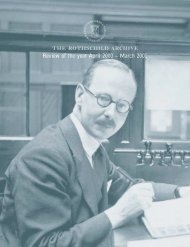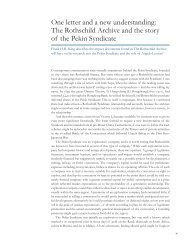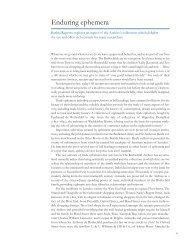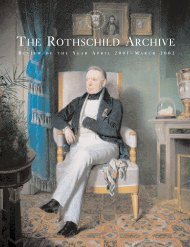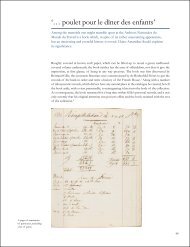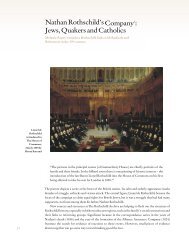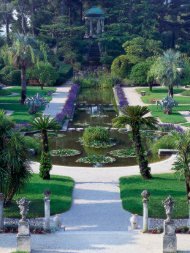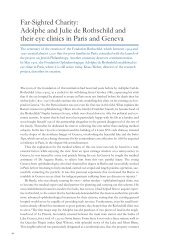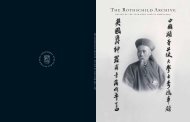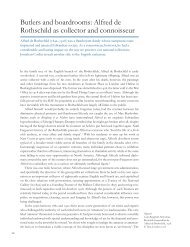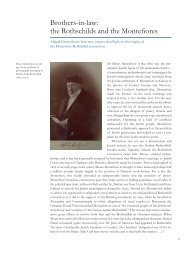66900 Rothschild Archive - The Rothschild Archive.
66900 Rothschild Archive - The Rothschild Archive.
66900 Rothschild Archive - The Rothschild Archive.
Create successful ePaper yourself
Turn your PDF publications into a flip-book with our unique Google optimized e-Paper software.
Halton House, Alfred’s<br />
Buckinghamshire estate<br />
shortly after completion.<br />
Minister Rosebery to frame a second Treasury Minute two years later, however, he became a<br />
central and controversial one. <strong>The</strong> ‘Rosebery Minute’ of 1894 redefined the Trustee/Director<br />
relationship, curtailing the latter’s power to buy on his own authority and increasing the Board’s<br />
power. Alfred candidly admitted at a board meeting that this had been his idea, that ‘the change<br />
in the terms of the Director’s appointment had been suggested by himself after consultation<br />
with Lord Rosebery’. ₁ ⁵ Three years later at the Wallace Collection Alfred and his fellow Trustees<br />
similarly succeeded in convincing Downing Street to restrict the powers of the first Keeper, the<br />
critic Claude Phillips. ₁₆<br />
<strong>The</strong> appointment in 1894 of E.J. Poynter to the now much-weakened Directorship drew a<br />
line under a particularly difficult selection process, which had seen Poynter’s claims as a practising<br />
artist pitted against the scholarly ones of Sidney Colvin, Keeper of Prints and Drawings<br />
at the British Museum. <strong>The</strong> knowledge of foreign galleries and history vaunted by Colvin was<br />
derided as ‘archaeological criticism’ or ‘mere antiquarianism’ by opponents, who included leading<br />
artists such as Holman Hunt and Burne Jones. ₁ ⁷ <strong>The</strong> new scholarship’s basis on German<br />
foundations made it seem part of a foreign plot to replace connoisseur values with a pseudoscientific<br />
discipline that mingled dry theory with a weakness for the latest artistic fads. At a time<br />
when the ‘New Art Criticism’ of D.S. MacColl and Frank Rutter was helping to fuel interest in<br />
shocking new phenomena such as Impressionism and Whistler’s ‘arrangements’, faddism was a<br />
serious charge indeed.<br />
Alfred followed up the Minute with a series of campaigns that made it next to impossible<br />
for Directors to continue filling ‘gaps’ as Eastlake had done. Between 1895 and 1902 he regularly<br />
attacked Poynter’s acquisition of what he saw as a series of overpriced works by secondary<br />
masters. ₁ ⁸ This despite the fact that he was often physically absent from meetings. His ability<br />
to make his views known even at a distance was based partly on a series of strongly-worded,<br />
professionally printed memoranda, which he first sprung on the Board in 1897. <strong>The</strong>se connoisseurial<br />
manifestoes were rammed home by his allies on the board, above all Lord Redesdale and<br />
the 5th Marquis of Lansdowne, whose pro-German foreign policy views made him a natural<br />
partner. <strong>The</strong>se fellow Trustees also made life difficult for Poynter, publishing their own broadsides<br />
and further restricting his powers by the ‘Lansdowne Resolutions’ of 1902. That Poynter<br />
was able to remain as Director until 1904 in the face of <strong>Rothschild</strong>’s campaign was largely due<br />
to the continued support of a renegade Trustee, the 9th Earl of Carlisle. Poynter’s successor,<br />
Charles Holroyd, broke down under the strain, as <strong>Rothschild</strong>’s arrogance was compounded by<br />
the arrival on the board of Curzon, a famously proud aristocrat who plumed himself on his eye<br />
for administrative detail and who shared Alfred’s low opinion of Holroyd.<br />
Alfred’s petulant opposition to the acquisition of works by less renowned masters gave way<br />
31



